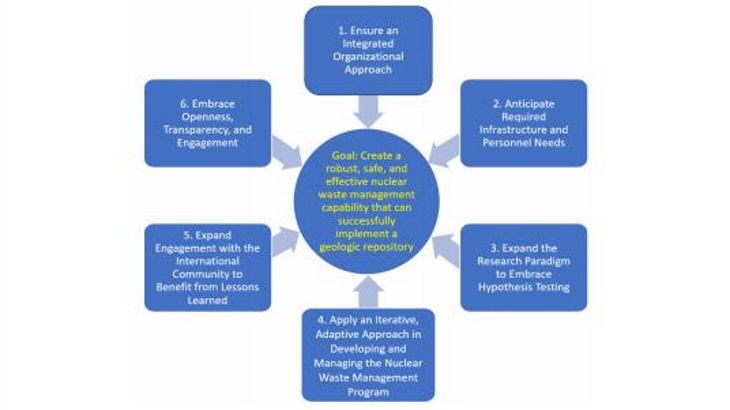NWTRB was established by Congress to evaluate the technical and scientific validity of the DOE’s work related to the management and disposal of used nuclear fuel and high-level radioactive waste.
In its report, it makes six recommendations concerning: an integrated organisational approach; required infrastructure and personnel needs; the DOE’s research approach; an iterative, adaptive waste management programme approach; engaging with the international community; and building public trust.
"We strongly believe the progress the nation is making in developing its waste management capability, as well as public and stakeholder acceptance, could be improved with regard to both timeliness and effectiveness by adopting these recommendations as core principles of the nuclear waste management programme," the NWTRB says in the report, which was published on 30 April.
The USA has accumulated one of the largest inventories of spent nuclear fuel (SNF) in the world, the report notes, from both the operation of commercial nuclear power plants and government operations related to research and development, and defence programmes, with the commercial inventory continuing to grow. In addition, there is a large inventory of government high-level waste (HLW), derived mainly from defence programmes, with some stored as liquid in tanks and the remainder encapsulated in glass.
"Studies have shown that SNF and HLW can be safely stored on the surface for an extended period of time if associated recommendations and programmes are followed, such as processing liquid HLW stored in underground tanks to a vitrified waste form," the reports says. "However, timely progress toward the long-term solution - disposal in an underground geologic repository - is still required as the lack of a solution to dispose of existing radioactive waste is costly and one of the major impediments to the nation’s further development of nuclear energy."
Its recommendations are:
- Inform and engage the public and other affected stakeholders early in the planning and review of all aspects of the nuclear waste management programme;
- Be transparent in decision-making and provide support for meaningful stakeholder participation;
- Take account of lessons learned in other countries about listening to and informing the public, in order to improve communications, better understand community perspectives, and avoid unnecessary delays of the programme;
- Though not a licence requirement for any new site selected for a repository, DOE should develop and make available a clear characterisation of the facility early in the process that describes the waste management concept and its multiple barriers and other attributes that contribute to safety. DOE must also clearly acknowledge and communicate its commitment that the safety concept will be revised to update it as new information and input are received;
- Develop site-suitability criteria prior to the start of site selection so as to minimise any ambiguity and latitude in their interpretation, thus helping to ensure the objectivity of the process and public confidence in its outcome. If, at any point during the siting process, the criteria need to be changed, a transparent and meaningfully participatory process to do so needs to be followed.
- If the USA develops one or more underground research laboratory, these laboratories, in addition to their research function, should be utilised for outreach and public engagement, in order to provide access to the subsurface and to build public confidence and trust in the science and engineering behind the safety concept as well as in the operational capabilities for remote handling of waste underground.






_91467.jpg)
_47120.jpg)
_16439.jpg)





